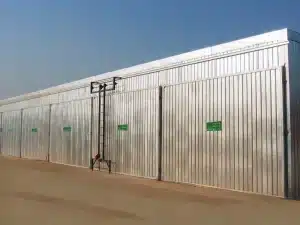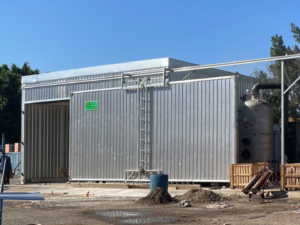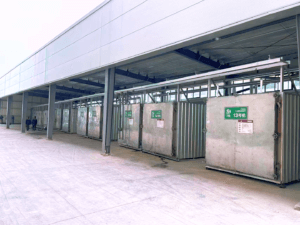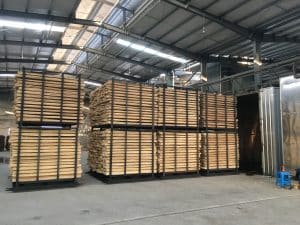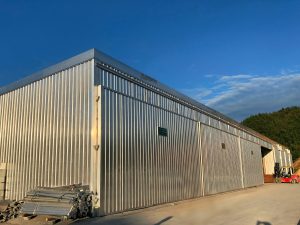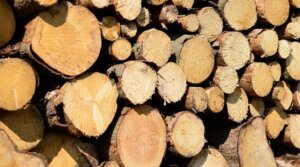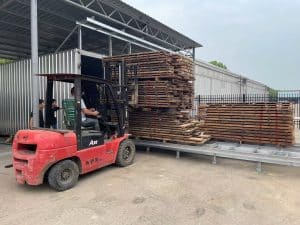In the realm of global trade, wooden pallets and crates are essential. To prevent the spread of pests and meet international trade regulations, these packaging materials must comply with ISPM 15 standards. A heat treatment kiln is the key to ensuring both phytosanitary compliance and structural durability for these wooden packaging materials.

Table of Contents
What Is ISPM 15 and Why It Matters?
ISPM 15 (International Standards for Phytosanitary Measures No. 15) requires that wood packaging materials be:
- Debarked
- Heated to a core temperature of 56°C for at least 30 minutes
- Stamped with a certified ISPM 15 mark
Our ISPM 15-compliant heat treatment kiln for wooden pallets guarantees these requirements are met efficiently and consistently.
Key Features of Our Heat Treatment Kiln for ISPM 15:
- Real-time monitoring of core wood temperature
- Automated data recording: temperature, humidity, time, and moisture content
- Remote data transmission to inspection authorities
- Full traceability and audit compliance
- Ideal kiln for wooden pallets, crates, and export packaging
It transmits the collected data to a remote computer (commodity inspection department), enabling remote monitoring of the packaging box heat treatment process. This system ensures full compliance with ISPM 15, supports audit traceability, and helps exporters meet the highest international standards for wood packaging safety.
Understanding Wood Dryer Kilns and Their Functionality
Wood dryer kilns are thermal processing chambers designed to apply heat to materials at specific temperatures under controlled conditions. In the context of wooden packaging materials, wood dryer kilns are primarily used for the drying and treatment of wood to meet compliance regulations and prevent the spread of pests.
International Standards and Compliance
One of the key compliance challenges in using wooden packaging is adherence to the International Standards for Phytosanitary Measures (ISPM 15) guidelines. These regulations are enforced worldwide to prevent transnational pest infestations. Kilns are used to heat-treat wooden materials to ensure they meet these standards, providing a bug-free guarantee required for international shipping.
Enhancing Durability with Kilns
The drying process in kilns significantly enhances the durability and strength of the wood. By reducing the moisture content in the wood, the risk of decay, mold, and fungi growth is minimized. This not only extends the lifecycle of wooden packaging materials but also ensures they maintain their structural integrity over longer periods. Click here to explore more
Economic Viability and Cost Efficiency
Kiln drying, although an upfront investment, tends to be economically beneficial in the long run. By improving the life span of wooden packaging and reducing losses from infestations and deterioration, businesses can maintain better profitability. Moreover, technologies like Techdrying offer innovative solutions that enhance the economic viability of using wood dryer kilns in wooden packaging.
Types of Kilns Used in the Industry
There are various types of kilns employed, each with specific advantages. Conventional dry kilns, such as those outlined on Techdrying’s conventional drying kiln page, are popular for their simplicity and effectiveness in large-scale operations. Other types include dehumidification kilns and solar kilns, each serving specific needs depending on climate and operational scale. For more info click here
Innovations in Kiln Technology
Recent technological advancements have seen wood dryer kilns become more energy-efficient and easier to operate. Companies like Techdrying have been at the forefront of these developments, offering patented technologies that promise enhanced performance, sustainability, and automation, making the wood dryer kiln drying process more accessible and environmentally conscious.
The Role of Kilns in Sustainability
As environmental concerns rise, the sustainability of using wooden packaging treated in wood dryer kilns has gained attention. Kiln drying ensures that wood used in packaging can be recycled or reused multiple times, thus reducing forest depletion stress. Additionally, the process helps in carbon preservation as when used multiple times, these materials continue to store CO2, mitigating environmental impact.
Regulatory Challenges and Opportunities
While wood dryer kilns play a pivotal role in adhering to international regulations like ISPM 15, there are ever-evolving compliance requirements across different regions. Staying updated with these changes is crucial. Companies like those found on Techdrying offer consultation to help navigate these regulatory landscapes effectively.
Key Factors Influencing Kiln Selection
The selection of a kiln involves evaluating various factors such as the type of wood, expected output, environmental concerns, and regional regulations. For businesses contemplating purchasing kilns, resources like Techdrying’s website provide valuable guidance on considerations for optimal kiln investment.
Future Prospective of Kiln Use in Packaging
The future of kiln usage in the wooden packaging industry is promising, with continual advancements anticipated in energy efficiency and operational automation. As new market demands emerge, the flexibility and adaptation offered by modern kilns will be invaluable in ensuring compliance and maintaining high durability standards.
Key Takeaways
Kilns remain an integral part of the wooden packaging industry, providing solutions that enhance compliance, durability, and sustainability. Their adoption not only ensures adherence to international standards but also contributes to the long-term economic and environmental value of wooden packaging materials. The continued evolution in kiln technology, championed by leading companies such as Techdrying, further cements their role in future logistical frameworks.
FAQs
What are kilns used for in the context of wooden packaging materials?
Kilns are primarily used to apply heat treatment to wooden packaging materials to meet international phytosanitary standards such as the ISPM 15 guidelines. This process eliminates pests and prevents the spread of infestation during the shipment of goods across international borders. Kilns also aid in reducing the moisture content in wood, thereby enhancing its durability and structural integrity, which is essential for sustained use in packaging applications.
How do wood dryer kilns contribute to the economic viability of wooden packaging?
While kilns require an initial investment, they contribute substantially to the economic viability of wooden packaging by extending the material’s life span and reducing losses due to pest infestation and decay. By ensuring compliance with international shipping standards, kilns help prevent costly quarantines or rejections during export. The durability imparted to the wood through kiln drying means that wooden packaging can be reused multiple times, enhancing profitability in the long run.
Are there different types of kilns used for wooden packaging, and what are their benefits?
Yes, there are several types of kilns used for processing wooden packaging materials. Conventional dry kilns, such as those offered by companies like Techdrying, are widely used owing to their straightforward operation and effectiveness. Dehumidification kilns offer energy efficiency and control over the drying process, while solar kilns present a more environmentally friendly option, albeit less effective in humid climates. Each type of kiln offers specific advantages depending on the operational scale, environmental considerations, and budget constraints.
What should companies consider when choosing a heat treatment kiln for wooden pallets?
When selecting a kiln, companies must consider numerous factors, including the type and species of wood, regulatory compliance requirements, desired output capacity, and local climate . It’s beneficial to evaluate advanced options that offer automation and energy-saving features. Consulting with industry experts and relying on established providers like Techdrying can aid in acquiring a kiln that matches the operational needs and strategic goals concerning sustainability and cost-efficiency.

